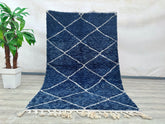Facts About a Moroccan Rug
A Moroccan Rug: A Timeless Tradition in Home Decor
A Moroccan rug is much more than a floor covering; it's a piece of Moroccan history and artistry, handwoven by skilled artisans from Morocco's diverse regions. Typically crafted from natural wool, these rugs are celebrated for their vibrant colors and unique patterns. Traditionally used as floor mats or tent coverings, Moroccan rugs now serve as exquisite tablecloths and wall hangings, adding warmth and character to any space.
Moroccan Hairpieces from the Atlas and Rif Mountains
Moroccan hairpieces and textiles are often made from fleece sourced from sheep or goats in Morocco's mountainous regions, particularly the Atlas and Rif Mountains. Atlas Mountain artisans often use sheepskin, producing soft and flexible rugs, while in the Rif, the stronger goat hair results in a more durable texture, ideal for withstanding heavy use. Each area brings a unique quality to these textiles, making Moroccan rugs as diverse as the land from which they originate.
Moroccan Rug Designs: Patterns and Symbolism
The beauty of Moroccan rugs lies in their intricate designs, typically showcasing geometric patterns with floral or animal motifs. The most common colors—red, blue, and green—each carry cultural significance: red symbolizes courage, blue represents wisdom, and green is associated with growth and fertility. The designs vary by region, with Atlas Mountain rugs featuring bold geometric shapes, while rugs from the Rif Mountains lean toward delicate floral and animal-inspired designs. These motifs aren’t just beautiful; they tell stories of resilience, wisdom, and life.
A Rich History of Moroccan Rugs
The history of Moroccan rugs spans centuries, originating as early as the 11th century when they were first noted by Arabic geographers as vibrant woolen creations. By the 14th century, Moroccan traveler Ibn Battuta praised their unmatched beauty and craftsmanship. The 16th and 17th centuries saw Moroccan rugs reach new heights of popularity, gracing royal palaces and noble estates across Europe. Today, while these rugs are more accessible, they retain their cultural value and artisanal quality, continuing to be woven by skilled hands that pass down this craft through generations.
Colors and Designs in Moroccan Rugs
Moroccan rugs are known for their powerful visual impact, created through colors and designs that carry deep symbolic meanings. Colors like red for courage, blue for knowledge, and green for growth give each rug a distinctive personality, while the patterns vary according to the weaver’s heritage and region. Rugs from the Atlas Mountains often showcase geometric motifs, while those from the Rif Mountains display more floral and animal designs, adding variety to the Moroccan rug market.
Caring for Your Moroccan Rug: Maintenance for Longevity
Investing in a Moroccan rug means investing in a piece of art and history. To keep its beauty intact, regular care is essential. Vacuuming your rug weekly prevents dirt from settling, while spot-cleaning small spills helps preserve its colors and fibers. If your rug encounters water, allow it to dry thoroughly to avoid damage. Annual professional cleaning also removes embedded dirt and extends the rug’s lifespan, allowing you to enjoy its unique beauty for decades.
Where to Buy a Moroccan Rug and What to Expect
For an authentic Moroccan rug, explore WoolBerberRug.com. Our online store offers a curated selection of Moroccan rugs, with prices ranging from $200 to $2000, depending on the design, size, and quality. If you’re searching for a unique, one-of-a-kind piece, our team is ready to help you find the perfect rug to enhance your home. Reach out to learn more about our collection and bring a piece of Moroccan heritage into your space.
Embrace the timeless appeal of Moroccan rugs and elevate your home with a piece of history and craftsmanship!
Featured Products
169 x 251 cm = 5.5 x 8.2 ft moroccan wool rug, moroccan style rug, bohemian rug, handmade rug, outdoor patio, beniourain Rug, decor rug, Handmade Gift
- $599.00
$1,830.00- $599.00
- (-67%)
- Unit price
- / per
155 x 247 cm = 5.1 x 8.1 ft Diamonds Blue Soft Dots Berber Runner Rug - Handmade Moroccan Wool, Minimalist Design, Vintage Style, Perfect for Weddings & Bohemian Decor
- $599.00
$1,830.00- $599.00
- (-67%)
- Unit price
- / per
- Authentic Moroccan rug
- Beni Ourain
- Beni Ourain rug
- Beniouraincarpets
- Berber rug history
- Custom Area Rug
- Custom Beni Ourain Rug
- Custom Moroccan Rugs
- Handmade carpet
- Handmade rug imperfections
- Luxury home decor
- modern moroccan rug
- Moroccan Berber rug
- Moroccan home décor
- Moroccan rug
- Moroccan rug authenticity
- Moroccan rug buying guide
- Natural fiber rugs
- Neutral hue rugs
- Plush texture rugs
- Rug craftsmanship
- Rug personalization
- soft moroccan rug
- Traditional rug design
- Vintage Moroccan Rug
- white beni ourain
- Wool Rug










